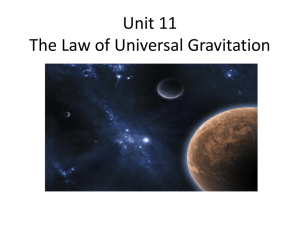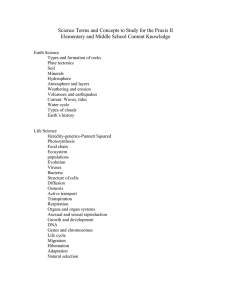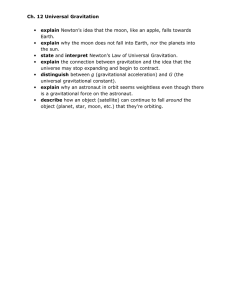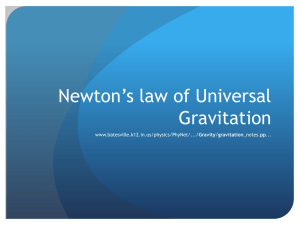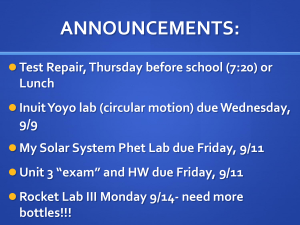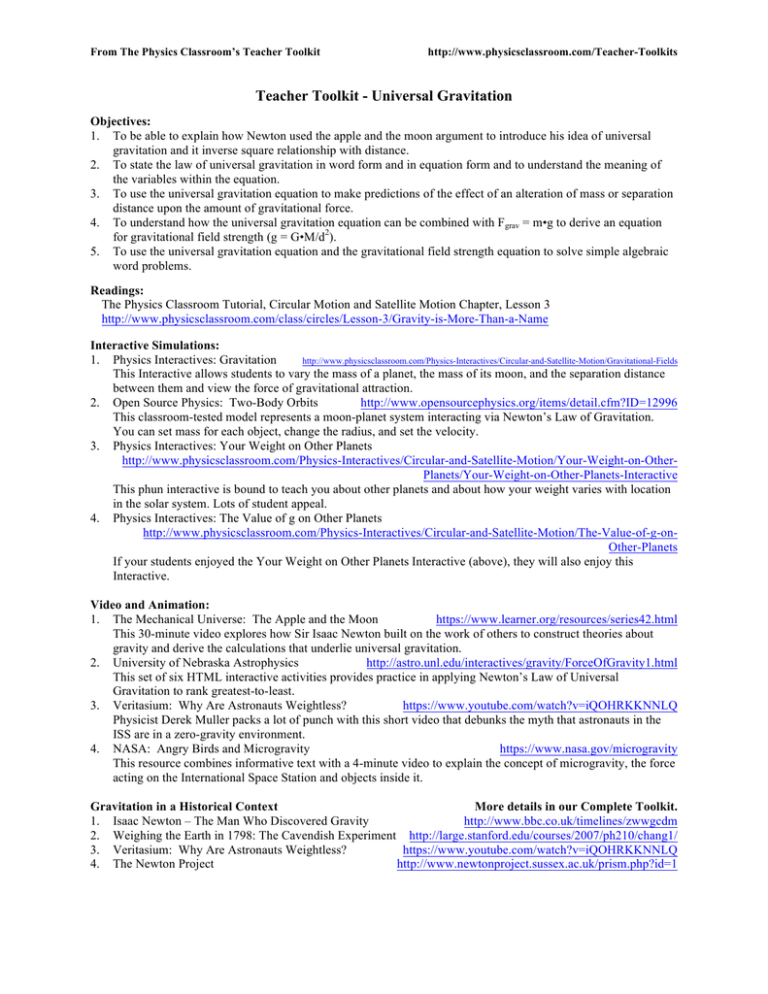
From The Physics Classroom’s Teacher Toolkit
http://www.physicsclassroom.com/Teacher-Toolkits
Teacher Toolkit - Universal Gravitation
Objectives:
1. To be able to explain how Newton used the apple and the moon argument to introduce his idea of universal
gravitation and it inverse square relationship with distance.
2. To state the law of universal gravitation in word form and in equation form and to understand the meaning of
the variables within the equation.
3. To use the universal gravitation equation to make predictions of the effect of an alteration of mass or separation
distance upon the amount of gravitational force.
4. To understand how the universal gravitation equation can be combined with Fgrav = m•g to derive an equation
for gravitational field strength (g = G•M/d2).
5. To use the universal gravitation equation and the gravitational field strength equation to solve simple algebraic
word problems.
Readings:
The Physics Classroom Tutorial, Circular Motion and Satellite Motion Chapter, Lesson 3
http://www.physicsclassroom.com/class/circles/Lesson-3/Gravity-is-More-Than-a-Name
Interactive Simulations:
1. Physics Interactives: Gravitation
http://www.physicsclassroom.com/Physics-Interactives/Circular-and-Satellite-Motion/Gravitational-Fields
This Interactive allows students to vary the mass of a planet, the mass of its moon, and the separation distance
between them and view the force of gravitational attraction.
2. Open Source Physics: Two-Body Orbits
http://www.opensourcephysics.org/items/detail.cfm?ID=12996
This classroom-tested model represents a moon-planet system interacting via Newton’s Law of Gravitation.
You can set mass for each object, change the radius, and set the velocity.
3. Physics Interactives: Your Weight on Other Planets
http://www.physicsclassroom.com/Physics-Interactives/Circular-and-Satellite-Motion/Your-Weight-on-OtherPlanets/Your-Weight-on-Other-Planets-Interactive
This phun interactive is bound to teach you about other planets and about how your weight varies with location
in the solar system. Lots of student appeal.
4. Physics Interactives: The Value of g on Other Planets
http://www.physicsclassroom.com/Physics-Interactives/Circular-and-Satellite-Motion/The-Value-of-g-onOther-Planets
If your students enjoyed the Your Weight on Other Planets Interactive (above), they will also enjoy this
Interactive.
Video and Animation:
1. The Mechanical Universe: The Apple and the Moon
https://www.learner.org/resources/series42.html
This 30-minute video explores how Sir Isaac Newton built on the work of others to construct theories about
gravity and derive the calculations that underlie universal gravitation.
2. University of Nebraska Astrophysics
http://astro.unl.edu/interactives/gravity/ForceOfGravity1.html
This set of six HTML interactive activities provides practice in applying Newton’s Law of Universal
Gravitation to rank greatest-to-least.
3. Veritasium: Why Are Astronauts Weightless?
https://www.youtube.com/watch?v=iQOHRKKNNLQ
Physicist Derek Muller packs a lot of punch with this short video that debunks the myth that astronauts in the
ISS are in a zero-gravity environment.
4. NASA: Angry Birds and Microgravity
https://www.nasa.gov/microgravity
This resource combines informative text with a 4-minute video to explain the concept of microgravity, the force
acting on the International Space Station and objects inside it.
Gravitation in a Historical Context
More details in our Complete Toolkit.
1. Isaac Newton – The Man Who Discovered Gravity
http://www.bbc.co.uk/timelines/zwwgcdm
2. Weighing the Earth in 1798: The Cavendish Experiment http://large.stanford.edu/courses/2007/ph210/chang1/
3. Veritasium: Why Are Astronauts Weightless?
https://www.youtube.com/watch?v=iQOHRKKNNLQ
4. The Newton Project
http://www.newtonproject.sussex.ac.uk/prism.php?id=1
This is the To Go version of the Teacher Toolkit; it is an abbreviated version of the complete Toolkit.
Labs and Investigations:
http://www.physicsclassroom.com/lab#circ
1. The Physics Classroom, The Laboratory, Solar System Sports Spreadsheet Study
Elsewhere on the Web:
1. The Torsion Balance Experiment
https://www.fourmilab.ch/gravitation/foobar/
Want to build a torsion balance system but can’t afford the $2,000 kits from science supply houses? This is for
you; the page provides 3 labs, all about gravity.
2. Understanding of Gravity, Gunstone and White http://onlinelibrary.wiley.com/doi/10.1002/sce.3730650308/abstract
If you invest in only one research article about gravity, we suggest you rent and read this article (available from
Wiley Online Library for $6.00).
3. NOVA: All About G Forces
http://www.pbs.org/wgbh/nova/space/gravity-forces.html
What’s behind g forces, and how much can the human body stand? This readable, informative article from
NOVA takes a deep look at the phenomenon we call “g force” as it relates to acceleration of humans.
Educational Research
See the Complete Toolkit on our website for links to research articles.
Demonstration Ideas:
1. YouTube - Frank Noschese: Cavendish Experiment
https://www.youtube.com/watch?v=dyLYbvZIYoU
This 2-minute video demonstrates a torsional system similar to the Cavendish torsional spring apparatus.
2. NASA: Microgravity
http://spaceflightsystems.grc.nasa.gov/DIME_Documents/SEEC/docs/HowToDemo-2013.pdf
Features “incredibly cheap” classroom demonstration ideas and devices used to measure microgravity.
Minds On Physics Internet Modules:
http://www.physicsclassroom.com/mop
Minds On Physics is a collection of interactive questioning modules that target a student’s conceptual
understanding. Each question is accompanied by detailed help addressing the various components of the question.
1. Circular Motion and Gravitation, Ass’t CG6 - Newton’s Law of Universal Gravitation
2. Circular Motion and Gravitation, Ass’t CG7 - The Acceleration of Gravity
Concept Building Exercises:
http://www.physicsclassroom.com/curriculum/circles
1. The Curriculum Corner, Circular Motion and Gravitation, Universal Gravitation
2. The Curriculum Corner, Circular Motion and Gravitation, The Inverse Square Law
Problem-Solving Exercises:
http://www.physicsclassroom.com/calcpad/circgrav
1. The Calculator Pad, Circular Motion and Gravitation, Problems #16-21
Standards:
A. Next Generation Science Standards (NGSS) – Grades 9-12
Performance Expectations – High School Physical Science
• Forces and Motion HS-PS2-4
Disciplinary Core Ideas – High School Physical Science
• Forces and Motion-Types of Interactions - HS-PS2.B.i
• Forces and Motion-Types of Interactions - PS2.B.ii
Crosscutting Concepts: Scale, Proportion, and Quantity; Systems and System Models
Science and Engineering Practices
• Practice #1: Analyzing and Interpreting Data
• Practice #2: Developing and Using Models
• Practice #3: Planning and Carrying Out Investigations
• Practice #5: Using Mathematics and Computational Thinking
B.
Common Core Standards for Mathematics (CC) – Grades 9-12
See the Complete Toolkit on our website for details.
C.
Common Core Standards for English/Language Arts (ELA) – Grades 9-12
See the Complete Toolkit on our website for details.
©The Physics Classroom, All Rights Reserved
This document should NOT appear on other websites.



